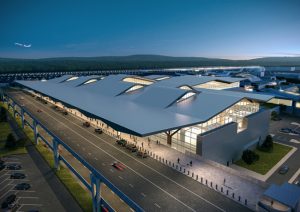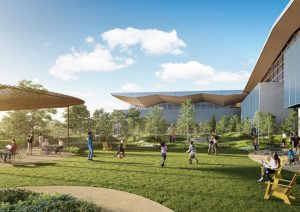
Another example of rapid change within the terminals is the use of next-gen smart-glass technology to transform windows into digital flight and wayfinding tools while offering equally impressive energy efficiencies. This is something we are doing in Boston Logan International Airport’s Terminal E modernization. Dynamic glass affords airports the ability to provide clear, digital information for passengers who can view it at a safe distance.
I foresee broadening of the airport’s funnels to include open space, a taste of the outdoors, and pavilion-like areas with ceilings that allow exposure to sunlight. Even spaces with long, dreary hallways can be transformed into culture centers, reflecting a city’s history or geographic strengths.
What are some examples of airports that are already employing these designs? How can airports meet these design criteria, while being within budget?
Vidal: At the Pittsburgh International Airport, we designed a new terminal adjacent to the gates for check-in, security, and baggage claim. In association with Gensler and HDR, we considered Pittsburgh’s iconic rolling hills, its industrial history, and technological future. This brought me to our design theme, “NaTeCo,” the merger of nature, technology, and community. The design is unique to Pittsburgh, incorporating regional characteristics emulating natural elements where possible. For example, the terminal has areas that function like a pavilion in a forest. The outside also blends with the inside, and vice versa. We created spaces where one can be outside, or have the feeling of being outside, even when inside.
In Boston Logan International Airport, we served as vision and concept architects alongside AECOM for the modernization of Terminal E. We looked at Boston, observed its characteristics, and made salient design choices. This included integrating the color red. I found Boston’s shading and its sunsets to be incredibly vibrant. Boston’s historic and iconic buildings along the waterfront are all made of red brick—tying buildings together with nature. So, for the roof, we developed a unique prismatic red paint in a lab in Switzerland to emulate the sunsets. The shading of this differs, depending on the viewer’s angle, shifting from reddish hues and orange to bright-red and a darker color. We wanted to highlight Boston’s dynamism and vibrancy.
With innovation occurring rapidly, and hastened by the global health crisis, architects are taking it upon themselves to integrate these safety measures and introduce bold, transformative designs, thereby meeting clients’ design goals while also staying in budget.
Sustainability remains critical. A sustainable airport of the future will be recognizable, resourceful, sleek, dynamic, and forward-thinking. Even the careful placement of windows in an airport, and the way they introduce natural sunlight, can limit the amount of solar radiation exposure that the space needs, drastically reducing energy consumption and the electricity bill.

What can existing airports do to reduce their energy consumption?
Vidal: Infrastructure projects, which are inherently large, resource-dependent and, by most measures, relatively inefficient, may present the most challenges to sustainable design. At the same time, done correctly, these projects may be able to achieve the greatest gains toward long-term sustainability.
Existing hubs can consider reasonable design upgrades to adapt to the new global climate and its many technological and safety demands. It may seem obvious, but long-term sustainability will depend on flexibility. We must maximize square footage, even in existing spaces, while providing a feeling of space, cleanliness, and safety. Flexibility may indeed be the cornerstone of sustainable design. Executives may wish to consider upgrading their facilities where necessary, perhaps adding square footage where possible, or bringing new technologies to an entirely new terminal, etc.
At luis vidal + architects, we develop designs that not only uniquely cater to a region, but also rely on various systems to reduce environmental output. One useful strategy is relying on materials that are found in the proximity of the project, geographically. In fact, we will always show a preference for materials that can be sourced near a construction site. Using local materials meets our criteria for suitability and is an environmentally friendly approach, reducing transportation-related emissions. It is also culturally responsible, supporting the local economy, and very cost-effective for the project owners.
In the design of the new terminal at the Pittsburgh International Airport, we made a conscious decision to incorporate a great deal of wood in the finishing materials. Wood is prevalent in the local environment and, as a result, we will be able to reduce the amount of carbon emissions to move the product once the project is under construction. Other eco-friendly materials include cork, coconut, almond shells, peanut shells, and more. These items can be processed to become building materials. Further, brick, which is made from clay, is a very environmentally friendly material. Bricks also retain heat well and insolate from the cold. The use of high-performance glass is also important. These are all factors to explore on new projects or redesigns.
What roles can architects, engineers, and planners play when it comes to designing the airports of the future?
Vidal: We learned and made a lot of changes and continue to do so after the September 11 attacks, mainly for the way passengers maneuver through security and begin a more rigid airport experience. So, in the wake of the COVID-19 pandemic, we will advance our learning on how to build a safer and healthy future: preparing for uncertainty and balancing safety with freedom. As architects, it remains our mission to create recognizable, resourceful, sleek, dynamic, and forward-thinking facilities. It is our duty, as architects, engineers, and planners, to make the airport “journey” memorable, iconic, and efficient. Using innovative and sophisticated systems, involving both active and passive measures, the ecological footprint of airports should, and can, be greatly reduced.
Overall, the airport of the future will be flexible to accommodate rapidly changing conditions, a lesson made apparent by 2020. The underlying factor is that an airport must account for its many byproducts, including its vibrancy and the passenger experience, to its long-term carbon footprint.
Through our work, we have seen just how crucial air travel is to the human race. We have, and will retain, a need to explore. It is the architect’s duty, then, to embrace innovation, effectively integrate the space into its surroundings, and exhaust all safety measures. This will ensure the user experience is positive, seamless, and conducive to long-term success.




